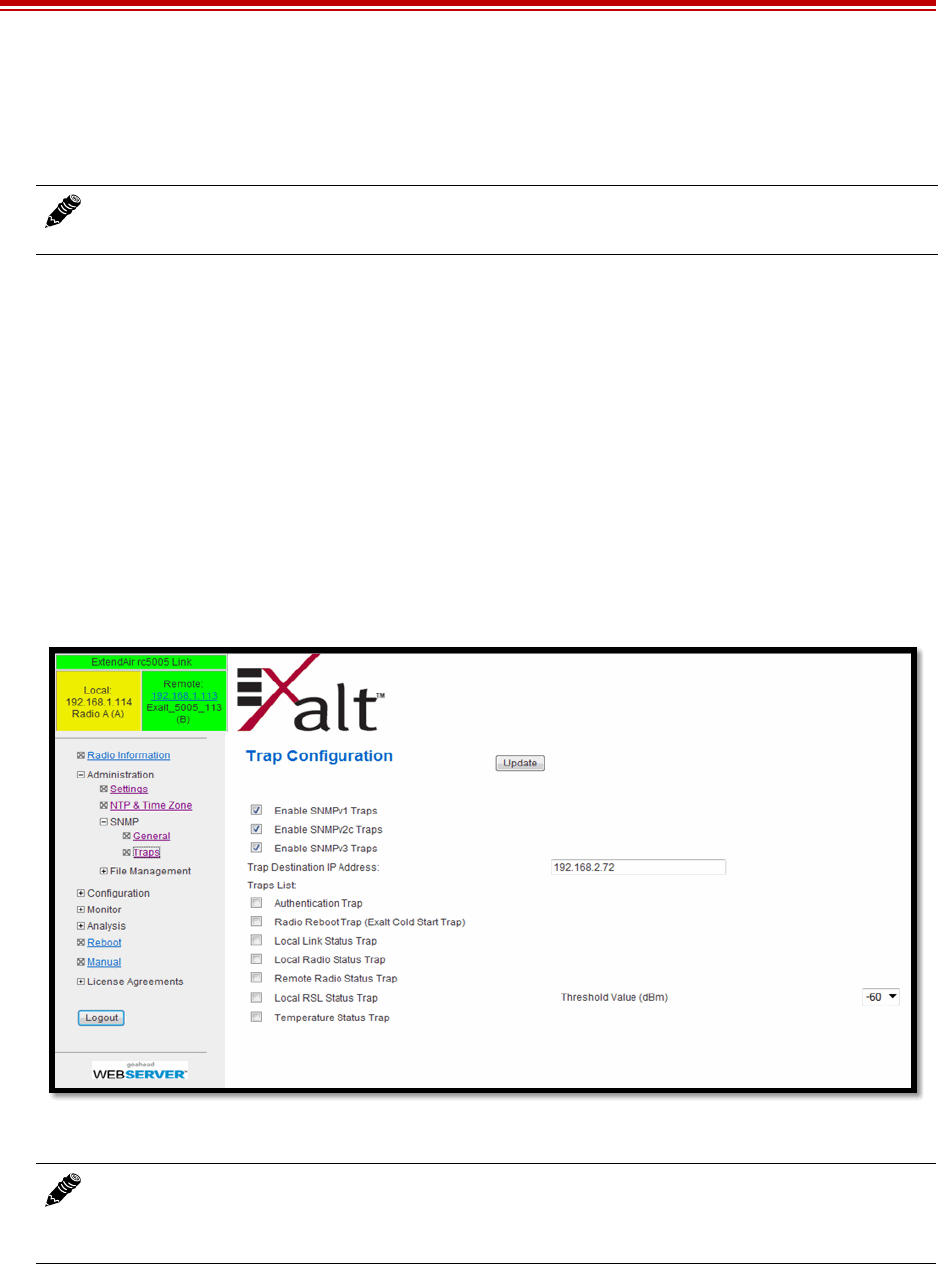User Manual
Table Of Contents
- ExtendAir® (TDD) Series Digital Microwave Radios Installation and Management Guide
- Legal Notice
- Open-Source License Information
- Table of Contents
- Notes for Customers of the Cisco Configuration ExtendAir r5005
- About this Document
- Introduction
- Pre-installation Tasks
- Link Engineering and Site Planning
- Familiarization with the ExtendAir (TDD) Series Radios
- Initial Configuration and Back-to-Back Bench Test
- Time Division Duplex (TDD) Factors
- Link Orientation and Synchronization
- Radio Synchronization
- Offset Timing
- Virtual Local Area Network (VLAN)
- Simple Network Management Protocol (SNMP)
- System Installation and Initiation Process
- Installation
- Configuration and Management
- Telnet into the Command Line Interface (CLI)
- Telnet
- Exalt Graphical User Interface (GUI)
- Quick Start
- Navigating the GUI
- Radio Information Page
- Administration Settings Page
- NTP and Time Zones Configurations Page
- Simple Network Management Protocol (SNMP) Configuration
- File Management Pages
- File Transfer Page
- File Activation Page
- System Configuration Page
- Ethernet Interface Configuration Page
- T1/E1 Configuration Pages
- VLAN Configuration Page
- Ethernet Rate Limiting
- QoS Configuration Page
- Automatic Channel Selection (ACS) Page
- Syslog Configuration Page
- GPS Information Page
- Alarms Page
- Performance Page
- Event Log Page
- User Throughput Page
- Diagnostic Charts Page
- Spectrum Analyzer Page
- Ethernet Utilization Page
- Reboot Page
- Manual Page
- Specifications
- Interface Connections
- Antennas
- Troubleshooting
- Back-to-back Bench Testing
- General Compliance and Safety
- Dynamic Frequency Selection
- Safety Notices
- Regulatory Notices
- Regulatory Compliance
- EIRP Limits for the United States and Canada
- EIRP Limits for Australia
- EIRP Limits for the European Union and ITU Countries
- Declaration of Conformity to the R&TTE Directive 1999/5/EC
- Exalt Limited Hardware Warranty Software License and RMA Procedures Agreement
- Copyright Notices
- Index

Exalt Installation and Management Guide
ExtendAir (TDD) Series Digital Microwave Radios
44 203591-011
2013-02-22
SNMP v1/v2c/v3 Support Options
Enable the SNMPv1/v2c options to allow entering read and read/write community strings.
Enable the SNMPv3 options to allow entering read and read/write user names and passwords. These
entries are de-coupled from the standard radio user names and passwords. SNMPv3 provides full
management security.
SNMP Traps
SNMP traps alert the central network management system with important issues about the radio
system. Trap filters are set on the Traps Configuration page (). Not all i-Series radios support SNMP
traps. Consult the release notes for more information.
Trap support for all versions of SNMP are provided and can be independently enabled. Enter the IP
address to which the traps are directed in the Trap Destination IP Address field. The AUX port (or the
MAIN port when using in-band management) must be connected to the network to allow trap
information to reach the designated IP address. In a bridged network, this may not require special
network settings. In a routed network, the connected router must have a defined path for the IP address.
Figure 23 Trap Configuration page
The following traps are available:
• Authentication Trap: This is an SNMP standard trap when password information for SNMP is
incorrect. This can help identify unwanted intrusions into the management system and for
diagnosis of SNMP issues for valid users.
Note: Users are encouraged to avoid enabling SNMPv1/V2c support due to known security
loopholes in these protocols.
Note: The Update button must be clicked to save any changes to this page.










